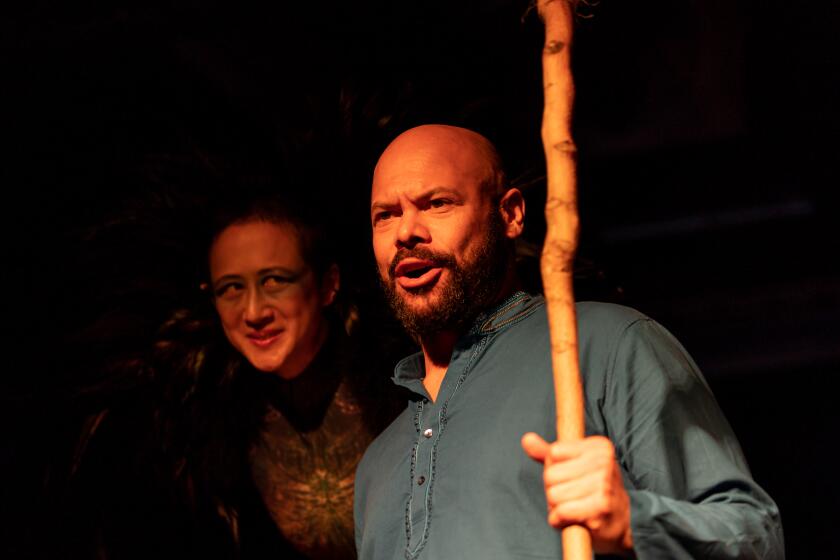OPERA OPENING : SAN DIEGO’S ‘ORIGINAL’ OFFENBACH ‘HOFFMANN’
SAN DIEGO — Poor Offenbach. He died in 1880, before he could put the finishing touches on what turned out to be his operatic masterpiece: “Les Contes d’Hoffmann.”
Well-intentioned hands began tinkering and tampering with his romantically macabre tales even before the premiere of a mutilated edition could take place at the Opera Comique of Paris in 1881. Scholars, meddlers and other patchwork virtuosi have been tinkering and tampering ever since.
The problem is simple. Offenbach purposely wrote more music than he needed, and he adopted a rather flexible attitude toward dramatic structure. It was his intention, no doubt, to shape “Hoffmann” during rehearsals.
That, however, was not to be. And, as a perverse fate would have it, much of the original manuscript was destroyed in a fire a few years after the first, quasi-bungled, performance.
There is, therefore, no such thing as an “original version.” Recent research, however, has uncovered more music and more clues to the composer’s dramatic intentions than several generations of devoted Offenbachians had believed existed.
It is now clear that the “Hoffmann” most of us know and love represents a distortion. Some of the most popular music has been added by outside helpers, some has been interpolated from other Offenbach sources, much has been cut and shuffled and re-ordered.
In the mid-’70s, German musicologist Fritz Oeser, with a little help from an American conductor named Antonio de Almeida, managed to piece together a big, sprawling, serious, fascinating, too-generous, still-not definitive “Hoffmann” package that purports to approach the beleaguered composer’s actual desires.
It was a reasonable facsimile of this brave new version that the enterprising San Diego Opera introduced to the West Coast at the opening of the season Saturday night at the Civic Theater. The production must have come as a shock to anyone familiar with editions regularly cranked out by the Metropolitan and New York City Operas, not to mention the one mounted here on two past occasions.
Nicklausse, the hero’s long-suffering mezzo-in-pants friend and abiding muse, has become a major character. He/she now gets to sing a big, showy, often florid, usually sentimental aria in each scene, whether we want it or not.
By the same token, the multiple villain should have become a somewhat less important force. His nasty aria in the Olympia act now emerges as a modest trio, and the famous aria in the Giulietta episode should be gone altogether.
On this occasion, however, the stellar basso in residence apparently couldn’t bear to give up his Big Moment. Authenticity be damned! Ergo, “Scintille, diamant” returned in the guise of an anachronistic indulgence.
And so it went. The often omitted epilogue was not just included. It was expanded to end with a transfiguring chorus extolling the triumph of art over love. Hoffmann lost his sensual reprise of “O Dieu, de quelle ivresse,” but gained a superb drunk scene that enabled him to reject Stella, the final incarnation of his eternal female nemesis.
This was a very long (3 3/4 hour) “Hoffmann,” and in some ways a rather unfocused, unwieldy “Hoffmann.” It also was a welcome demonstration of a thoughtful, provocative operatic venture in a city that has often settled for easy, crowd-pleasing solutions to thorny artistic problems.
Nathaniel Merrill, a solid routinier from the Bing era at the Met, offered a fluid, conventional staging scheme that favored picturesque cliches over fantastic invention or psychological probing.
Guenther Schneider-Siemssen’s sets and costumes, designed for the Miami Opera, relied on elaborate scrims and projections to convey a nice mad-scientist milieu for Spalanzani’s workshop, a nice expressionistic nightmare for Antonia’s house in Munich, and not much else worth remembering.
Theo Alcantara conducted reliably, and without much expressive force or poetic illumination.
Under the circumstances, the evening belonged to the singers--at least to some of them.
Luis Lima as Hoffmann brought rare boyish ardor to the early scenes, hysterical pathos to the epilogue, and a ringing, fresh, untiring spinto tenor to the dangerously high-lying cantilena. The only things he failed to bring, in fact, were the caressing mezza-voce accents that one longs to hear in the love music.
Judith Forst, replacing the originally scheduled Delores Ziegler, sang Nicklausse’s endless arias with bona fide panache. James Morris may not have been the most diabolical evil genius in memory, but as Dr. Miracle he mustered a terrific approximation of Nosferatu, and as Dappertutto he sang a glorious, full-throated, long-lined, downward transposed “Scintille, diamant.”
Nelly Miricioiu, remembered for a febrile Violetta in San Francisco, gurgled Olympia’s coloratura gingerly, sounded rough but eminently poignant as the lyrical Antonia, and exuded brash sexuality as a Giulietta who, in this version, meets an appropriately unhappy end.
The large supporting cast included Carlos Chausson as an insinuating Schlemil, Richard Crist as a dignified Crespel, Robert Schmorr as a nimble Spalanzani, and Leonard Eagleson as a rather clumsy quartet of servants.
The opera was sung, for the most part, in bad French and explained, much of the time, in distracting and unintentionally amusing supertitles.
More to Read
The biggest entertainment stories
Get our big stories about Hollywood, film, television, music, arts, culture and more right in your inbox as soon as they publish.
You may occasionally receive promotional content from the Los Angeles Times.










